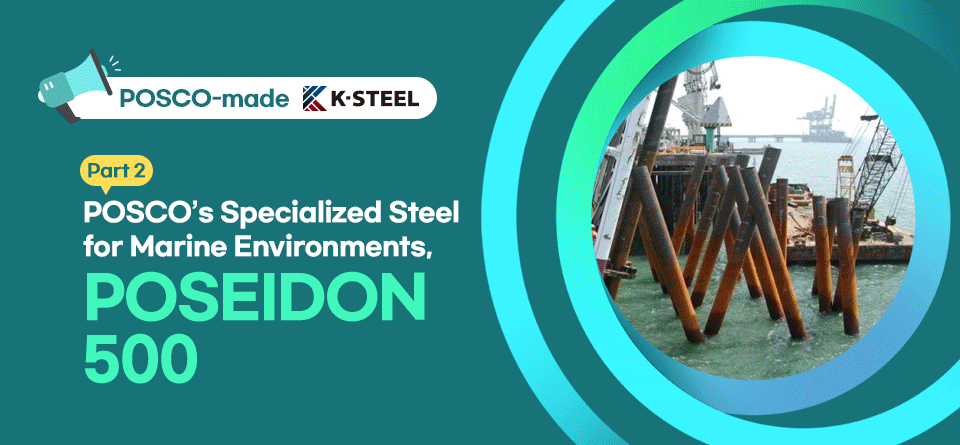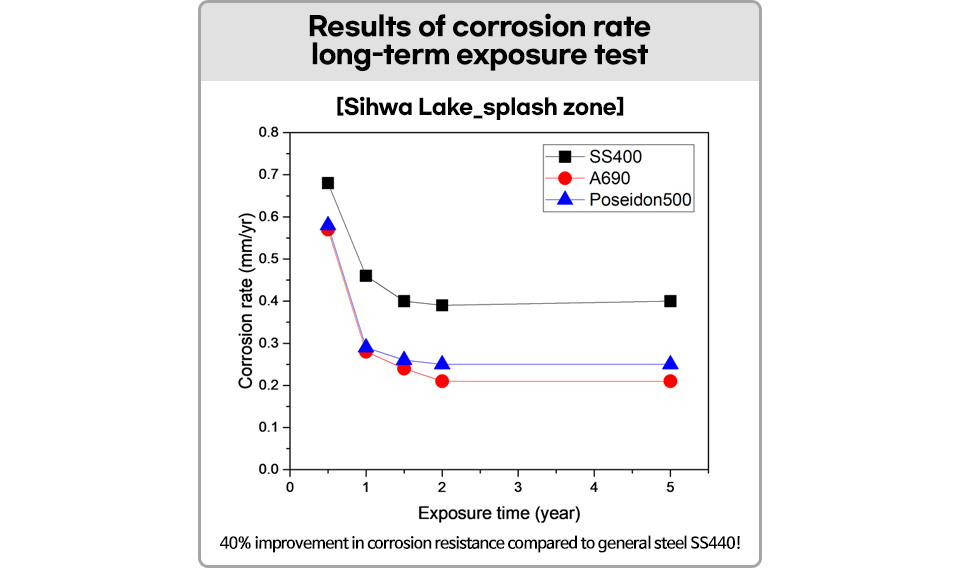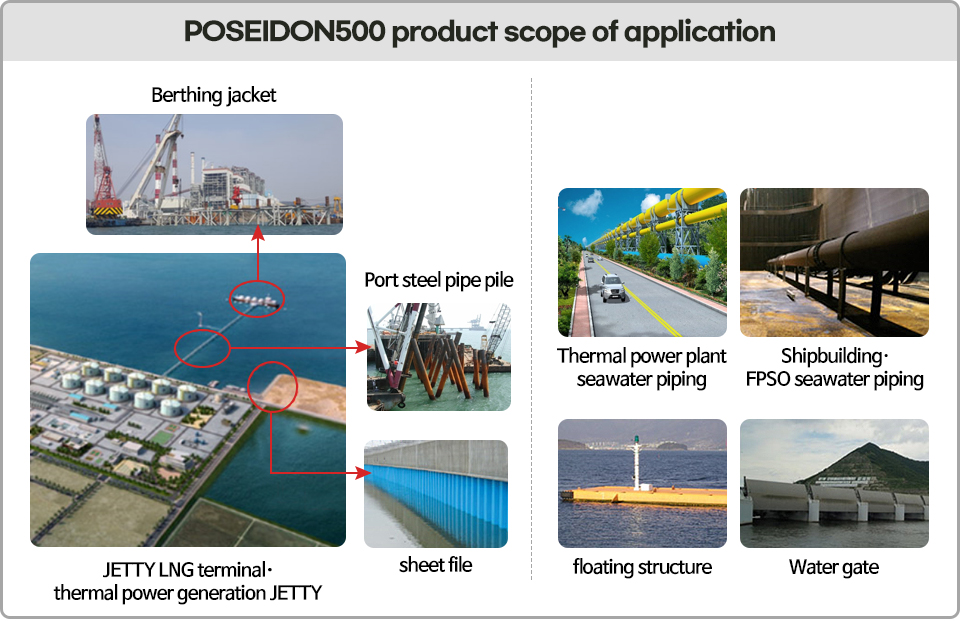
Providing satisfaction to customers with high-quality products and Sustainable steel solutions and striving to reduce CO2 emissions! Experts introduce POSCO’s new steel sheet products.
Chang-young Son, Senior researcher
(POSCO Construction Steel Materials Solution Group)

POSCO’s POSEIDON500, a specialized steel solution to combat corrosion in marine environments
In the past two years, POSCO has developed a novel construction technique using POSEIDON500, steel specially designed for high salt resistance, to enhance the durability and cost efficiency of port structures. Seawater contains salt, which corrodes steel more rapidly than other environments. In particular, the splash zone, the area immediately above and below the mean water level, faces direct exposure to seawater due to wave action. This exposure, coupled with an increased supply of oxygen, leads to a significantly higher rate of corrosion.
POSCO developed a specialized steel, POSEIDON500, to address and mitigate corrosion issues in marine environments. This steel has improved resistance to corrosion in the splash zone by more than 40% compared to conventional structural steel and contains just 1% of costly alloying elements such as chromium (Cr), which makes it a more cost-effective alternative to stainless steel.
The company has also reduced material cost by 10-15% with construction methods considering the material characteristics of specialized steel. Based on these strengths, the company plans to supply 20,000 tons of steel for LNG terminal construction projects in the latter half of 2023, and an additional 20,000 tons for quay and shore protection structures in 2025.
Improved customer satisfaction with high-performance, cost-efficient steel and tailored structural solutions
POSCO’s specialized steel for port and offshore structures is highly acclaimed in the market due to the company’s customer-focused and economically efficient research and development approach from the initial stage of steel development to its application in structures. Stainless steel is widely recognized as having excellent corrosion resistance, but it is costly due to its composition, which includes expensive alloying elements such as nickel (Ni) and a high chromium (Cr) content of 12% or more.
The use of stainless steel for structures that require a large amount of steel, such as harbor steel piles, is not cost-effective due to its high price, leading to a demand for more affordable materials.

POSCO took note of this and designed its steel with a low-cost component of approximately 1% chromium (Cr). POSEIDON500 was developed with a corrosion resistance of 40% or more in the splash zone compared to typical structural steel. When it is exposed to seawater, a layer of chromium oxide forms on its surface to inhibit corrosion.
Japanese steelmakers have also developed seawater corrosion-resistant steel that has a yield strength of 240 ㎫ and applied it to ships and plants. In contrast, POSCO’s offshore structural steel has the world’s highest yield strength of 380 ㎫ and tensile strength of 590 ㎫. Furthermore, POSCO provides customized structural solutions that consider the actual conditions in which steel will be used, leading to a high level of satisfaction among domestic customers.
POSEIDON500 outperforms low-cost imports and has completed a successful 5-year verification of its resistance to seawater corrosion
Before the development of POSEIDON500, which began in 2010, STP275 and STP355 were the primary materials used for port steel piles, and this was mainly low-cost hot rolled steel imported into Korea in large volumes. In response to the influx of low-cost imported steel, POSCO actively sought input from key stakeholders, including port-related clients, builders, and designers, to better understand their needs and perspectives. After considering various viewpoints, POSCO recognized that the low-cost imported steel fell short of customer expectations in terms of corrosion resistance and strength. Consequently, its research team began developing steel that would better fulfill these requirements.

At that time, Japan also developed seawater corrosion-resistant steel with a yield strength of 245 ㎫. However, its high cost hindered its application in port structures. So, its use was primarily confined to seawater piping in the shipbuilding industry. POSCO concluded that by enhancing the yield strength to 380㎫ and boosting corrosion resistance by 40%, it could achieve economic viability. Consequently, the company concentrated its efforts on research and development to realize these improvements.
This research began with uncertainty and was gradually fulfilled with twists and turns. At that time, POSCO aimed to release the steel as fast as possible by limiting its corrosion performance verification to just a basic indoor accelerated corrosion test. However, the company faced significant resistance in the process of registering KS standards and the design standards of the Ministry of Oceans and Fisheries from officials who demanded extensive, long-term corrosion resistance performance verification results for more than two years.
It was a critical challenge that threatened to bring the development process to a halt. But POSCO realized that the tough verification process could actually act as a shield to effectively control the influx of imported products into the country. This moment marked the turning point where a crisis was transformed into an opportunity for the creation of specialized steel.
Following a year of detailed planning, the company placed long-term corrosion test samples in the splash zone, tidal zone, and underwater zone in Sihwa, Gwangyang, and Pohang, representing the West, South, and East Seas, respectively. These samples were monitored for five years to rigorously assess their seawater corrosion performance. Based on this, POSCO went through all required procedures to enter the market by achieving registration of their steel with the KS standard in 2013 and the Ministry of Oceans and Fisheries’ harbor and port design standard in 2015.
POSEIDON500, spearheading advancements in port technology by expanding the scope of application

▲Cases of application to ports and marine structures.
After developing the steel, POSCO expanded its scope of application by innovating new construction methods for port structures. It has also expanded the scope of application by port structure type. It was first applied to steel pipe piles at Pohang New Port in 2016, followed by domestic piers,* coal-fired port facilities such as jetty steel pipe piles at the import/export pier of Shinseocheon Thermal Power Plant in 2019, the jacket structure at the Jinhae Submarine Base in 2020, marine bridge foundation of the Gwangyang dredged soil dump site in 2023, and the jetty** jacket structure and steel pipe piles at Gwangyang LNG Terminal 2 in 2023.

In particular, the company developed and supplied POSEIDON500 steel plates for the jacket structure as well as steel pipe piles at the Jinhae Submarine Base. Accordingly, POSCO plans to supply POSEIDON500 hot rolled steel and steel plates for both the steel pipe piles and jacket structures at Gwangyang LNG Terminal 2. In 2023, in collaboration with specialized builders and designers, POSCO intends to develop “walled steel pipe piles” designed for use in quay walls and shore protection that are expected to be applied in earnest starting from 2024.
While seawater corrosion-resistant steel such as POSEIDON500 has generally been confined to specific uses such as seawater pipes in shipbuilding and harbor sheet piles globally, POSEIDON500 is at the forefront of port technology innovation and is finding unique applications in key structural elements of harbors such as steel pipe piles and jacket structures.
*Pier: a docking facility created by placing steel pipe piles adjacent to land and then covering them with a concrete slab
**Jetty: a docking facility supported by piles that extends out from the land and is advantageous for larger vessels such as coal or LNG carriers
Part 1 : POSCO’s antiviral color steel sheets for buildings and home appliances
